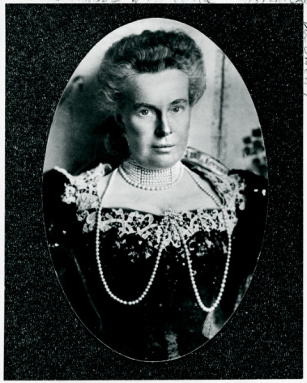
Legendary for her parties as well as her philanthropy, Elisabeth Mills Reid founded Mills Hospital.
Image courtesy: Mills-Peninsula Health Services
D.O. and Jane Mill’s son Ogden married “well” when he married Ruth Livingston. His sister Elisabeth also chose a spouse that would enhance the family’s position. In 1881, Elisabeth married the politically ambitious Whitelaw Reid, a journalist and editor of the New York Tribune. The wedding took place at the Millses’ palatial home at 634 Fifth Avenue, New York. Several months later, D.O. and Jane Mills invited San Francisco society to meet the newlyweds at a reception held at their Millbrae estate. Five hundred engraved invitations were mailed and special trains brought the guests to Millbrae from San Francisco. From the estate’s small train station, horse-drawn carriages carried the guests to the mansion. Hundreds of Japanese lanterns illuminated the path.1
Not long after their marriage, Reid began to dedicate himself to public service. He served as the Ambassador to France from 1889 to 1892. In 1892, the Reids returned to the United States where Whitelaw ran for vice president on Republican incumbent President Benjamin Harrison’s losing bid for re-election. In 1905, the Reids again went abroad, this time so that Whitelaw could serve as the Ambassador to the Court of St. James (i.e., the United Kingdom).
In addition to Whitelaw’s public service, the Reids were noted philanthropists. They were major benefactors of Columbia University: Reid Hall, a complex of academic facilities operated by Columbia University in Paris, is named after them.
Darius Ogden Mills was a widower for the last 22 years of his life. After her mother’s death in 1888, Elisabeth frequently traveled with her father, usually accompanying him on winter trips to his beloved Millbrae country home. While on one of these visits to California, she worked with the rector of St. Matthew’s Episcopal Church to found Mills Hospital, which opened in 1908 in the small but growing city of San Mateo.2 Mrs. Reid was apparently motivated to fund a local hospital when her close friend Abby Parrott Payson lost two children because no proper medical care was readily available on the mid-Peninsula.3 No doubt she was also motivated by her travels with her aging father. Darius Ogden Mills suffered a fatal heart attack at his Millbrae estate in 1910. He was 84.
Elisabeth donated her time, as well as her money, to her philanthropic activities. Prior to her marriage, she helped her father administer the Mills Hospital for Poor Folk in New York City. She also organized the New York Chapter of the American Red Cross. After she funded the initial organization of Mills Hospital, she remained involved, personally funding any annual deficit in the hospital’s finances, while at the same time soliciting financial support from others in the community. Until her death in 1931, she made annual inspections of the hospital.
As might be expected from the daughter of one of America’s wealthiest men, she did everything with great style. For years, the staff dining room at Mills Hospital was known for its superior food, served on fine china with real silver utensils set upon white linen tablecloths. The parties that Ambassador and Mrs. Reid threw in London were legendary, especially the Fourth of July garden parties, which were attended by as many as 5,000 guests. Some politicos complained that Ambassador and Mrs. Reid set such a high standard for entertaining that subsequent ambassadors of more modest means would never be able to compete. The Reids’ home in London, Dorchester House, was the greatest private residence in the greatest city of the world at that time.4
Ambassador Whitelaw Reid died unexpectedly in London in 1912. The Archbishop of Canterbury presided at his requiem mass at Westminster Abbey. The King arranged for a British ship to accompany Whitelaw’s body to the United States. Elisabeth Reid died in France in 1931.
Whitelaw and Elisabeth Reid had two children, Ogden Mills Reid and Jean Templeton Reid, who after her marriage was known as Lady Jean Templeton Reid Ward.
Continue reading the Founding Families story –>